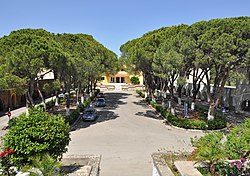Eleousa (Rhodes)
|
Eleousa Ελεούσα |
||
|---|---|---|
|
|
||
| Basic data | ||
| Country |
|
|
| region | South Aegean | |
| Regional district | Rhodes | |
| local community | Rhodes | |
| Parish | Kamiros | |
| Local community | Dimylia | |
| Geographic coordinates | 36 ° 17 ′ N , 28 ° 2 ′ E | |
| Residents | 228 (2011) | |
| LAU-1 code no. | 6901070302 | |
| View over the main square towards the former sanatorium | ||
Eleousa ( Greek Ελεούσα ( f. Sg. )), Often also written Eleusa , is a village on the Greek island of Rhodes . It was built on Rhodes under the name Campochiaro from 1935 during the Italian occupation . Since the administrative reform in 2010, the village has been part of the Dimylia community in the municipality of Kamiros .
location
The village is located about 40 kilometers from the city of Rhodes in a wooded area in the foothills of the Profitis Ilias mountain . The closest localities are Dimylia in the west and Archipoli in the east.
history
Campochiaro was built between 1935 and 1936 as a model village for the Italians according to plans by the architect Armando Bernabiti . It was supposed to serve as a housing estate for forest workers (partly from South Tyrol) who were supposed to reforest the then largely treeless Profitis Ilias . Each worker was given a house with land around a central rectangular square. On the square itself, a Catholic church was built on the short sides and an administrative building opposite. On the long sides of the square were two buildings with a cinema, the headquarters of the Fascist Party of Italy , a school, health facilities and shops. The electricity for the place was generated in a specially constructed hydropower plant.
In 1939, many settlers left Campochiaro after the British military shelled the island after Italy entered the war . In 1943 the island came under German control and the last Italian settlers left the village. The German military used Campochiaro as a base. When the island of Rhodes was assigned to the Kingdom of Greece in 1947 , the village was uninhabited. It was officially renamed Eleousa and the Catholic Church was converted into an Orthodox Church.
From 1947 to 1970 a sanatorium for tuberculosis patients was operated in Eleousa under the name Agia Eleousa. It was the largest hospital for this disease in the Dodecanese . When it opened, it could accommodate 80 patients who were cared for by 54 employees. The local climate is not ideal for healing the sick. The remote location, which made it easier to maintain a quarantine, was decisive for the decision to build the tuberculosis station here. Emmanuel G. Kostaridis was the scientific director of the sanatorium for many years.
Today some houses below the central square are inhabited again and there are several working taverns. The buildings around the square are falling into disrepair. A 30-meter-wide water basin from the former hydropower plant was restored with financial support from the European Union . It is part of a protection program for the threatened fish Ghizani .
After the annexation of the Dodecanese to Greece in 1947, Eleousa was first part of the then rural municipality Archipoli ( Κοινότητα Αρχιπόλεως Kinótita Archipóleos ) from 1948 and then from 1957 to the rural municipality Dimylia, which became part of the municipality of Kamiros in 1997 as part of the territorial reform .
- Population development of Eleousa
| 1947 | 1951 | 1961 | 1971 | 1981 | 1991 | 2001 | 2011 |
|---|---|---|---|---|---|---|---|
| 150 | 343 | 237 | 190 | 216 | 217 | 258 | 228 |
Web links
Individual evidence
- ↑ Results of the 2011 census, Greek Statistical Office (ΕΛ.ΣΤΑΤ) ( Memento from June 27, 2015 in the Internet Archive ) (Excel document, 2.6 MB)
- ↑ Campochiaro. Rhodes Explorer, accessed May 2, 2016 .
- ^ Andriana I. Papaioannou and Konstantinos T. Kostikas: The sanatorium of Saint Eleousa: An important part of the history of Respiratory Medicine on the island of Rhodes. Pneumon, 2010, accessed May 2, 2016 .
- ↑ Hans-Peter Siebenhaar: Rhodos . 4th edition. Michael Müller Verlag, Erlangen 2010, ISBN 978-3-89953-542-6 , p. 218 .
- ↑ Κεντρική Ένωση Δήμων και Κοινοτήτων Ελλάδας (ΚΕΔΚΕ) Ελληνική Εταιρία Τοπικής Ανάπτυξης και Αυτοδιοίκησης (ΕΕΤΑΑ) (ed.): Λεξικό Διοικητικών Μεταβολών των Δήμων και Κοινοτήτων (1912-2001). 1 (Τόμος A, a – K), Athens 2002, ISBN 960-7509-47-1 , Volume 1, p. 140.
- ↑ Κεντρική Ένωση Δήμων και Κοινοτήτων Ελλάδας (ΚΕΔΚΕ) Ελληνική Εταιρία Τοπικής Ανάπτυξης και Αυτοδιοίκησης (ΕΕΤΑΑ) (ed.): Λεξικό Διοικητικών Μεταβολών των Δήμων και Κοινοτήτων (1912-2001). 1 (Τόμος A, a – K), Athens 2002, ISBN 960-7509-47-1 , Volume 1, p. 291.
- ↑ Population of Eleousa 1947–2011 Greek Statistical Office ELSTAT, Digital Library ; Census 2011 (Greek)

